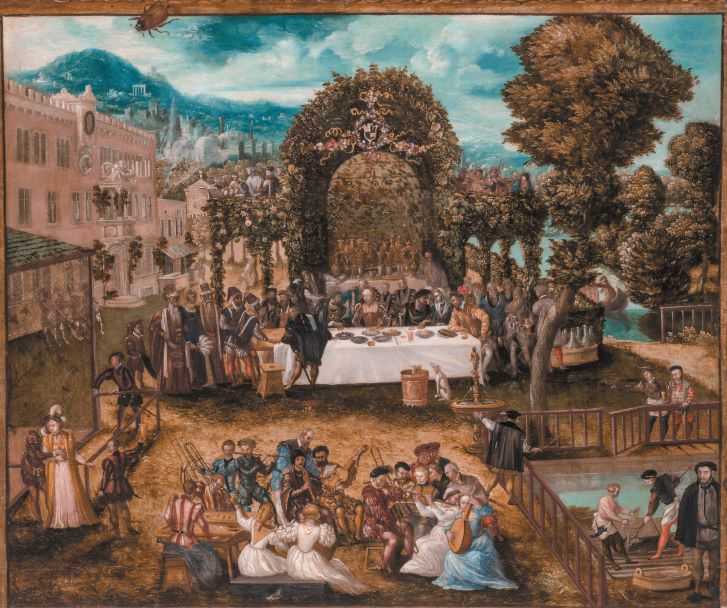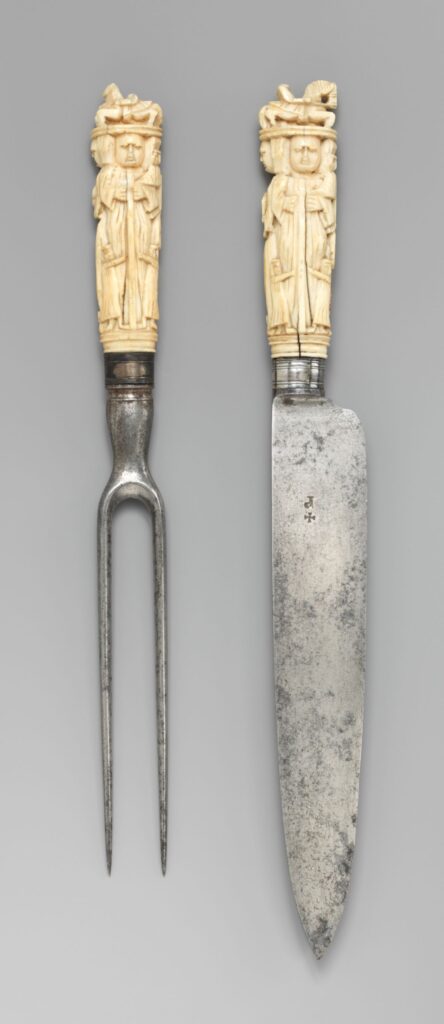
Da Vinci’s Last Supper may be the best-known dining scene committed to . . . well, wall . . . but it can’t hold a candle, in terms of detail and anthropological interest, to tableaux like Hans Mielich’s Outdoor Banquet of 1548. A group of upper-crust Italians in their best tights, puffy sleeves, and capes surround a table set before a credenza sagging with a trophy case’s–worth of gold serving vessels. A steward or carver—the master of ceremonies at Renaissance mealtimes—appears to be pulling back the tablecloth from the left, perhaps signaling that it is time for the final course of this service à la russe, and the two servants pulling fish from the pond at lower right provide a hint about what’s to come.

The painting is on view as part of Staging the Table in Europe 1500–1800 at the Bard Graduate Center, which examines the early modern traditions of dining service and spectacle, focusing on a group of illustrated books published between 1500 and the late eighteenth century across Europe. It is the nineteenth installment in the BGC’s decade-old “Focus Project” series of exhibitions, each of which is curated by a postdoctoral fellow or faculty member in collaboration with students. In this case it is the BGC’s chair of academic programs, Deborah L. Krohn, taking the lead, and building on her study of Bartolomeo Scappi’s 1570 Opera del arte del cucinare, believed to be the first illustrated cookbook.
Following Johannes Gutenberg’s invention of the printing press around 1436, the lore of civilized dining—which had been the exclusive domain of monarchs and ultra-rich nobles—began to filter down to clergy and statesmen across Europe, as well as to the middling sorts who would serve them at table. Giovanni Francesco Colle’s Refugio de povero Gentilhuomo, published in Ferrara, Italy, in 1520, is the first printed carving manual to be illustrated with the tools of the trade. A single woodblock plate—from the 1532 second edition—bled across the book’s gutter, identifies such instruments as a fruit knife, meat fork, and smembratore (dismemberer) for the benefit of ambitious servants who desired positions in elite households. Another valuable resource for carvers would have been the 1621 treatise Il Trinciante by Mattia Gieger, who also published a how-to on napkin-folding, one of the techniques behind eye-catching Renaissance centerpieces known as trionfi da tavola (triumphs of the table). Simple engravings of disembodied hands pleating broadcloth in books by Geiger and others served as inspiration for the starched linen crabs, fish, mountains, and birds on view—the work of contemporary Catalan napkin folder Joan Sallas, the most prominent practitioner of this nearly lost art, as well as its leading scholar.
No exhibition on dining would be complete without period trappings, and some forty examples of maiolica plates, Delft tureens, antique napkins and table clothes, and cutlery round out the show. Noteworthy among the latter category are a carving knife and fork whose handles are fashioned from walrus ivory, a throwback to the days when this Viking material was commoner in Europe than the tusks of elephants. And a 1663 damask napkin from the workshop of virtuosic Dutch linen weaver—and once and future mayor of Haarlam—Quirijn Damast, depicting two scenes from the story of Abraham and Isaac, is as detailed as any tapestry but at only forty-two by twenty-nine inches.

Staging the Table in Europe 1500–1800 • Bard Graduate Center, New York • to July 9 • bgc.bard.edu
